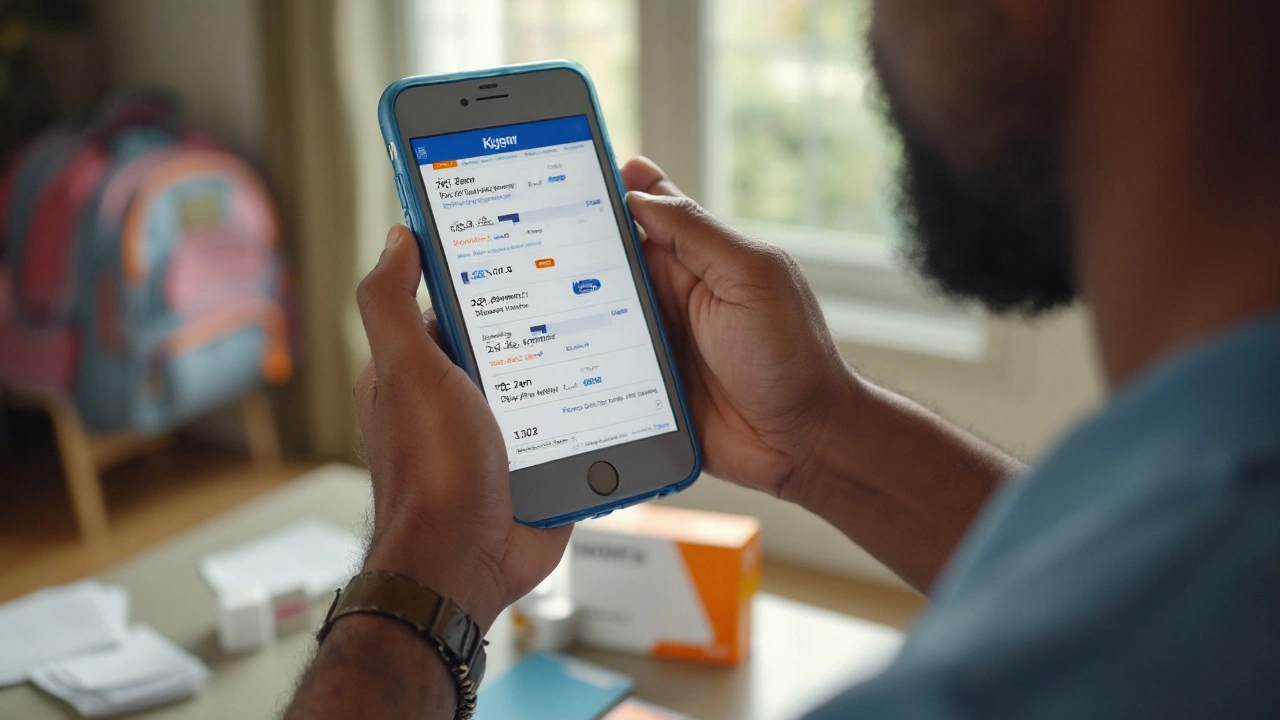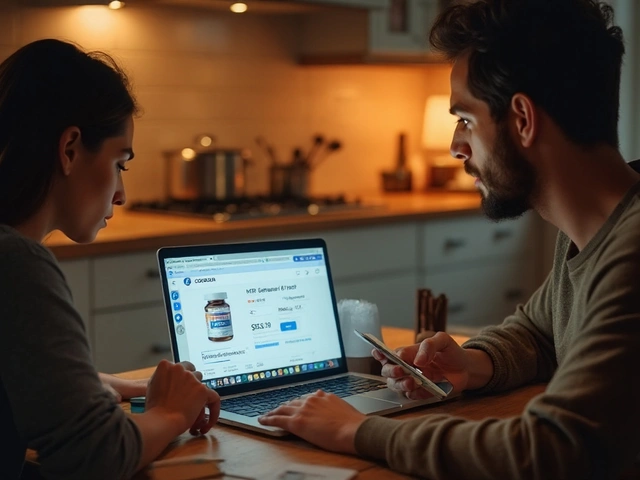
If you want the pain relief of Motrin without paying brand prices, here’s the simple truth: the generic-ibuprofen-works the same when it’s made to standard. Buying it online in 2025 is easy. The tricky part is avoiding sketchy sellers, choosing the right strength, and not getting stung on shipping or returns. I’ll show you how to buy safely, what to pay, and when ibuprofen isn’t the right call. I live in Auckland, so I’ll note New Zealand specifics, but I’ll also give you quick cues for the US, UK, and Australia.
What you probably want from this page: a quick way to confirm generic = Motrin; a safe path to buy online at a low price; realistic price benchmarks; a dosing cheat-sheet; and a plan B if ibuprofen doesn’t suit you. That’s exactly what you’ll get-nothing fluffy.
One more thing before we start. When I say “generic Motrin,” I mean ibuprofen. Motrin is a brand. The active ingredient is ibuprofen, and that’s what does the work.
What you’re actually buying: ibuprofen basics, dosing, and when to avoid it
Let’s anchor the basics, because it’s the difference between a good buy and a bad day. Ibuprofen is a non-steroidal anti-inflammatory drug (NSAID). It reduces prostaglandins-the chemical messengers behind pain, fever, and swelling. That’s why it helps with headaches, toothache, back strain, period pain, sprains, and a feverish cold. It usually kicks in within 30-45 minutes, peaks around 1-2 hours, and lasts 6-8 hours.
Generic ibuprofen that meets your country’s standards (Medsafe in NZ, FDA in the US, MHRA in the UK, TGA in Australia) is held to the same quality and bioequivalence benchmarks as the brand product. In plain speak: it should work the same at the same dose.
Common forms you’ll see online:
- Tablets/caplets: 200 mg (OTC almost everywhere), 400 mg (OTC in some countries, pharmacy-only in others), higher strengths like 600-800 mg are usually prescription-only.
- Liquids/suspensions for kids, often 100 mg/5 mL.
- Gel-caps/softgels for faster absorption feel. Same ibuprofen inside.
Practical adult dosing (always follow the label you buy):
- Typical single dose: 200-400 mg every 6-8 hours as needed.
- Max OTC daily dose: commonly 1,200 mg in many countries; higher totals (up to 2,400-3,200 mg) are prescription territory and supervision-only. Don’t push limits.
- Take with food or milk if your stomach complains. Hydrate.
Children: The safe dose is weight-based. Labels vary, but a common range is 5-10 mg/kg every 6-8 hours, max three to four doses per day. If a child is under 6 months (or under 3 months and under 5 kg, depending on country guidance), talk to a clinician before ibuprofen. When in doubt, get a pharmacist to confirm the exact dose by weight.
Who should avoid or check first:
- History of stomach ulcers, GI bleeding, inflammatory bowel disease, or you’re on blood thinners like warfarin-ibuprofen can raise bleeding risk.
- Kidney disease, heart failure, uncontrolled hypertension-NSAIDs can stress the kidneys and fluid balance.
- Asthma that gets worse with NSAIDs-some people react.
- Pregnancy-avoid ibuprofen from 20 weeks onward unless a clinician says otherwise; especially avoid in the third trimester due to fetal risks highlighted by regulators like the FDA. If pregnant or trying, ask first.
- Regular low-dose aspirin for heart protection-ibuprofen can blunt aspirin’s antiplatelet effect if mistimed. The usual advice: take ibuprofen at least 8 hours before, or at least 30 minutes after, immediate-release aspirin 81 mg. Confirm with your doctor or pharmacist.
Common interactions that actually matter:
- Other NSAIDs (naproxen, diclofenac): don’t double up-higher risk, not much extra benefit.
- Blood pressure meds (ACE inhibitors, ARBs, diuretics): NSAIDs can reduce their effect and strain kidneys-short-term use is usually fine for most, but keep it brief and hydrated.
- Alcohol: occasional moderate drinking is usually okay; heavy drinking + ibuprofen raises GI bleeding risk. Space them or skip booze on treatment days if you can.
How ibuprofen stacks up against alternatives:
- Paracetamol/acetaminophen: gentler on the stomach, good for fever and headaches, but not anti-inflammatory. A solid first line for many pains. Often combined in a schedule (they don’t interact) when pain is tougher-ask a pharmacist for a plan.
- Naproxen: longer-lasting relief (8-12 hours) for some musculoskeletal pains but still an NSAID with similar cautions.
- Topical NSAIDs (e.g., diclofenac gel): less systemic exposure, handy for localized sprains or knee pain.
Regulatory snapshot for quick context:
| Region | OTC strengths commonly sold | Typical OTC pack sizes | Max OTC daily dose | Notes / Regulator |
|---|---|---|---|---|
| New Zealand | 200 mg OTC (small packs often general sale), 400 mg usually pharmacy-only | 10-24 (general sale); 24-100 (pharmacy) | 1,200 mg | Medsafe; check Pharmacy Council for registered online pharmacies |
| United States | 200 mg OTC; higher strengths prescription-only | 24-500+ | 1,200 mg | FDA; look for NABP-approved sites or .pharmacy domains |
| United Kingdom | 200 mg OTC; some 400 mg pharmacy (P) medicines | 16-96 | 1,200 mg | MHRA/GPhC; registered pharmacy logo on sites |
| Australia | 200 mg OTC (S2/S3), 400 mg pharmacy-only in many cases | 24-96 | 1,200 mg | TGA; check AHPRA registration for pharmacies |
These are typical as of 2025; always follow the label and local rules. If a site tries to sell you 800 mg without a valid prescription where that’s not allowed, walk away.

How to buy it online safely and cheaply: steps, price benchmarks, and smart checks
You clicked here for a deal, not a headache. Here’s the fast path to getting legit ibuprofen at a low price.
Quick roadmap:
- Pick your form and strength (most adults just need 200 mg tablets; 400 mg can be handy to reduce pill count).
- Check the seller is a real, licensed pharmacy in your country.
- Compare price per tablet, not just the headline price. Include shipping.
- Check expiry dates, returns, and delivery time. Savings mean nothing if it arrives next month.
- Pay with a method that offers buyer protection.
1) Choose the right product before you compare prices
- For occasional headaches, period pain, or post-gym aches, 200 mg tablets are fine. Many people take 400 mg as a single dose (two 200 mg tablets) when needed.
- If you get stomach upset, try taking with food, switch to a film-coated tablet or gel-cap, or use topical gel for localized pain.
- For kids, stick with the labeled suspension and dose by weight. Don’t guess-use a proper syringe or spoon.
2) Verify the pharmacy is legit
- New Zealand: Prefer NZ-registered pharmacies. Look for a physical business name you can match on the Pharmacy Council’s public register. Medsafe is the medicines regulator; reputable sites will state their compliance, show a New Zealand address, and display a way to contact a pharmacist.
- United States: Look for NABP-accredited sites or .pharmacy domains. They require compliance checks, proper pharmacist contact, and prescription handling.
- UK/EU: Legit sites display the MHRA (UK) or EU common pharmacy logo that clicks through to a register entry. Check the General Pharmaceutical Council (GPhC) for UK pharmacy registration.
- Red flags anywhere: no pharmacist contact, only a webform, hides who they are, sells prescription strengths without a prescription, crazy-low prices, or asks to pay via gift cards/crypto.
3) Know what “cheap” really looks like in 2025
Price ranges shift, but here are sane ballparks for plain, non-branded ibuprofen from licensed sellers. Your local taxes and courier rates apply.
- New Zealand: 200 mg small packs (10-24) often NZ$3-$8. Larger pharmacy packs (48-100) commonly NZ$8-$18. 400 mg pharmacy-only packs (24-50) might run NZ$10-$20. Delivery for online pharmacy orders is often NZ$3-$7 or free above a spend threshold.
- United States: 200 mg generics can dip to US$0.02-$0.10 per tablet in larger bottles (100-500 count). Watch for shipping; many big retailers ship free above a minimum.
- United Kingdom: 200 mg tablets often £0.35-£1 for 16s in supermarkets/pharmacies; larger boxes like 96s can be ~£2-£6 online.
How to compare fairly:
- Price per 200 mg = Total price (including shipping) ÷ number of 200 mg tablets.
- For 400 mg tablets, normalize by dose: price per 400 mg or halve to compare against 200 mg tablets.
- Don’t buy more than you can use before expiry unless the per-tablet savings are significant.
4) Shipping, returns, and freshness
- Delivery time: If you need pain relief today, click-and-collect or walk into a local store. Online bargains are great for replenishing, not urgent headaches.
- Expiry dates: Aim for at least 12 months remaining. Most legit pharmacies list or confirm if you ask. Ibuprofen is usually stable, but don’t rely on expired meds.
- Returns: Unopened medicines often have strict return rules. Read them before you buy.
5) Payment and data safety
- Use a credit card or a trusted payment service that offers dispute resolution. Avoid bank transfers to unknown sellers.
- Look for “https” and a padlock in the browser. If the site looks like it was built yesterday, trust your gut.
Safe-buying checklist you can actually use:
- Match the pharmacy’s name and address to your country’s official register.
- See a real pharmacist contact method (phone/email/chat during business hours).
- Product is labeled with the active ingredient “ibuprofen,” strength (e.g., 200 mg), and a local license number.
- Price per tablet is within the ranges above. If it’s unbelievably low, there’s a reason.
- Shipping cost and delivery window are clear before checkout.
- Expiry date on request. Returns policy visible.
- Payment via a protected method. Website uses encryption (https).
What about importing from overseas to save more?
Be careful. Rules vary. In New Zealand, customs and Medsafe can stop non-compliant imports. Small personal supplies of OTC medicines are generally less of a problem than prescription meds, but it’s still smarter to use an NZ-registered pharmacy for quality, storage guarantees, and easier returns. The same logic applies in most countries: local accredited pharmacies keep you on the right side of quality and law. If a seller ships from an unknown warehouse with no oversight, skip it.
How brands and generics differ in real life
- Brand names like Motrin or Nurofen sometimes use coatings or gel-caps that feel faster, but bioequivalence standards mean generics should reach similar blood levels in a similar time window.
- If you feel one product works better for you, that’s valid-stick with it. But for most people, generic ibuprofen at the same dose gets the job done at a lower price.
Ethical CTA: If you’re set to buy online cheap generic motrin, do it through a licensed pharmacy in your country, pick the right dose for your needs, and compare price per tablet including shipping. If something looks off, ask a pharmacist. Pain relief shouldn’t be a gamble.

When ibuprofen isn’t the right tool: alternatives, scenarios, and quick answers
Sometimes ibuprofen is perfect. Sometimes it’s the wrong move. Here’s how to decide without second-guessing yourself.
Best-for / Not-for quick takes
- Best for: short-term musculoskeletal pain (sprains, back strain), period pain with cramps, dental pain, fever with aches, post-exercise inflammation.
- Not ideal for: people with past ulcers or GI bleeds, kidney disease, heart failure, or NSAID-exacerbated asthma; late pregnancy; people on certain blood thinners.
Alternatives that make sense
- Paracetamol/acetaminophen: good when stomach tolerability matters. Safe with ibuprofen if used at labeled doses (many clinicians alternate them for tough pain). Don’t exceed paracetamol’s daily max (often 3,000-4,000 mg; some labels cap at 3,000 mg-check yours).
- Naproxen: longer relief between doses. If you need less frequent dosing and tolerate NSAIDs well, it’s an option. Same cautions as ibuprofen.
- Topicals: diclofenac gel on a sore knee or ankle can help with fewer systemic effects.
- Non-drug moves: cold/heat, rest, compression, elevation, gentle mobility-cheap and surprisingly effective when done right.
Scenarios and trade-offs
- Recurring tension headaches: Try hydration, posture breaks, paracetamol first; use ibuprofen sparingly. Frequent use of painkillers can trigger rebound headaches.
- Period pain: Many find ibuprofen or naproxen helpful. Start at the first sign of cramps for better effect. If pain is severe every cycle, consider a medical review.
- Toothache before a dental visit: Ibuprofen can take the edge off inflammation; pairing with paracetamol (separate drugs, labeled doses) often works better than either alone. See a dentist-painkillers don’t fix the cause.
Mini-FAQ
- Is generic Motrin the same as brand? Yes. The active ingredient is ibuprofen, and generics must meet bioequivalence standards set by regulators (e.g., FDA, Medsafe, MHRA, TGA).
- How many can I take at once? Most adults take 200-400 mg per dose. Don’t exceed the label’s maximum daily amount (commonly 1,200 mg OTC). If you need more or for longer than a few days, talk to a clinician.
- Can I take ibuprofen with paracetamol/acetaminophen? Yes, they work differently. Many clinicians alternate them for short periods in tough pain. Stick to labeled doses and avoid combination products that double-count ingredients.
- Does ibuprofen upset the stomach? It can. Take with food, don’t mix with other NSAIDs, and keep doses reasonable. Persistent stomach pain, black stools, or vomiting blood-seek care immediately.
- What about pregnancy and breastfeeding? Avoid ibuprofen from 20 weeks of pregnancy unless a clinician says otherwise; especially avoid late pregnancy. In breastfeeding, ibuprofen is usually considered compatible at normal doses by many guidelines (due to low transfer into milk), but confirm locally if unsure.
- Will it interfere with my low-dose aspirin? It can if taken at the wrong time. If you take daily immediate-release aspirin for your heart, take ibuprofen at least 8 hours before or 30 minutes after the aspirin dose. Confirm with your doctor or pharmacist.
- Does it affect COVID-19 vaccines or colds? No special issues for most people. Use as needed for fever/pain unless your clinician advises otherwise.
Sources I trust
Regulatory and clinical guidance from Medsafe (NZ), the Pharmacy Council of New Zealand, the US FDA, the UK MHRA and GPhC, Australia’s TGA and AHPRA, and standard dosing references like the British National Formulary and national guidelines support the dosing, safety, and pharmacy verification steps above. Your local pharmacist is your fastest, most practical source of personalized advice.
Next steps / Troubleshooting
- I need it today: Order online for click-and-collect from a registered pharmacy, or buy a small pack in-store. Online shipping won’t beat a same-day headache.
- The price looks high: Compare price per tablet including shipping. Check bigger packs, try a different licensed pharmacy, or use a generic store brand.
- I keep getting stomach irritation: Reduce to the smallest effective dose, take with food, consider swapping to paracetamol or a topical NSAID, and ask a pharmacist about gastroprotection if you need NSAIDs often.
- I’m on meds or have a condition: Message the pharmacist on the site before checkout. A two-minute chat can prevent a bad interaction.
- My order is delayed: Check the tracking and the seller’s delivery window. If it’s outside their promise, ask for a refund or reshipment. For urgent needs, buy a small local pack to bridge the gap.
- I’m tempted by a super-cheap overseas site: If it sells prescription strengths without a prescription, hides who they are, or uses odd payment methods, back out. Stick to accredited pharmacies you can verify on an official register.
Bottom line: go generic, buy from a licensed pharmacy you can verify, compare price per tablet including shipping, and use ibuprofen smartly. That’s how you get the relief you wanted at the price you wanted-without the risk.





Comments (15)
Neha Bharti
Start by matching the product label to the active ingredient "ibuprofen" and the strength you actually need, that single check saves a lot of trouble.
Pick 200 mg for occasional headaches or fever, 400 mg when you want fewer pills and your system tolerates it, and keep kid doses strictly weight-based with the right syringe.
For online buys, normalise price to price-per-200 mg tablet including shipping, and don’t be seduced by headline pack prices that omit postage.
Samantha Patrick
Double-check the listed regulator or pharmacy register number and then compare it to the official register, that step quickly tells you if a site is legit or sketchy.
Also note that many sites list 400 mg as OTC but local rules might make it pharmacy-only, so follow the local label not the seller’s blurb.
Pay with a credit card for buyer protection and keep screenshots of the product page and checkout for your records.
Ryan Wilson
Don’t skimp on common sense when buying meds online, cheap prices can mask bad storage and fake batches.
If it’s absurdly cheap and they ask for crypto or gift cards, that’s not a bargain, it’s a red flag and you should bail.
Stick to registries and trusted payment methods and you’ll avoid half the horror stories people love to share.
EDDY RODRIGUEZ
Verify the pharmacy registration before you hit buy, that single step avoids most scams.
I always check the regulator logo and then cross-reference the business name on the official register for quick proof, that double-check usually takes less than a minute and saves days of hassle.
If the site hides its physical address or uses weird payment methods, I drop it instantly and move on to a clearly listed, licensed seller.
Shipping and expiry are underrated; a cheap price is worthless if the batch is near expiry or sits in an uncooled warehouse for weeks, so ask for expiry info or a pic if needed.
For everyday 200 mg tablets, stock up only enough to use within a year unless the savings are huge and the seller has a solid returns policy.
Kids dosing needs a proper syringe and dose math by weight, no guessing, because dosing errors are common and avoidable and you don’t want to be That Parent dealing with an overdose scare.
Pregnancy and kidney disease are red flags where a quick pharmacist chat pays off more than any discount, trust the pros on that one.
Ibuprofen vs acetaminophen is a simple call most times: stomach-sensitive folks do better on paracetamol, inflammation-driven pain responds better to ibuprofen, and alternating can help in tougher cases.
Alternate them when pain is stubborn, but keep counts and don’t mix products that secretly combine both ingredients, because accidental overdoses happen even to careful people.
Credit card protections and known payment gateways keep buyer disputes manageable if something goes wrong, and screenshots of the product page plus tracking numbers make refunds smoother.
I also check customer reviews not for star ratings but for recurring reports of stale stock, missing pharmacist contact, or maltreated packaging that points to shady logistics.
A legit online pharmacy will let you ask a pharmacist and will state return rules clearly for unopened meds, those are non-negotiable trust signals.
Topical NSAIDs are a great hack for localized pain when systemic risks are a worry, they often give relief without exposing the whole body to NSAID effects.
And when in doubt, local click-and-collect beats waiting for a cheap international shipment that might get stopped by customs and then become a headache itself.
Quality and legal compliance are the two pillars I won’t compromise on for any price, that’s my simple rule when a head or a back is hurting and I need something that actually works.
Buying cheap is smart, but buying blind is a false economy.
Christopher Pichler
Price per dose math is boring but essential, so normalise everything to the 200 mg unit and include shipping, taxes, and handling when you compare.
Large bottles in the US can be pennies per pill, but only buy bulk if you’ll use it within the product’s sensible shelf life.
Regulators require bioequivalence for generics, so most legit generics perform like brand-name Motrin at the same dose, and that’s the pharmacological baseline.
VARUN ELATTUVALAPPIL
Solid tips, act now!!!
April Conley
That payment-warning point is spot on, don’t hand over cash or crypto to strangers, period.
Local pharmacies often beat risky imports by being easier to return to and quicker to contact if something’s off.
Sophie Rabey
Nice callout on topicals and alternating meds, those practical tricks save a lot of stomach trouble and downtime.
Also worth noting that some people perceive small differences in formulation and stick to what works for them, which is fine if it’s legit and within dosing limits.
Bruce Heintz
Exactly, perception matters and adherence matters :)
Sticking with a familiar generic brand that you trust often beats switching for a tiny price saving.
richard king
Buying meds is like tending a small garden of remedies, you cultivate trust in suppliers the same way you cultivate soil, and then harvest relief when needed.
Cheap soil can choke the crop, and cheap meds can choke peace of mind, so the metaphor sticks.
Neha Bharti
Exactly, consistency matters more than chasing the cheapest bottle, especially if you rely on something for recurring pain.
Small recurring purchases from the same licensed pharmacy make tracking quality and expiry easier and build an implicit trust history that’s valuable.
Samantha Patrick
Also keep an eye on combination products and read labels carefully, many over-the-counter combos can have hidden acetaminophen that stacks with separate paracetamol doses.
Label reading is boring but lifesaving, and it’s a quick habit to form that prevents accidental exceedance of daily limits.
Use small notes or reminders when alternating drugs so you don’t lose track during a rough day.
EDDY RODRIGUEZ
For what it’s worth, I always keep a small first-aid stash of single-dose analgesics in a labeled pouch at home, that makes emergency decisions simple and keeps dosing mistakes low.
When ordering online for future use, I ask the seller for a batch or expiry photo via chat and keep the confirmation alongside the order receipt as proof.
That practice has saved me a return hassle once, and it’s low effort with a decent payoff.
Also, pharmacists are underrated allies, a 2-minute call can prevent an interaction or a pregnancy-related mistake that would otherwise cost time and worry.
So invest the minute to talk to a real pharmacist if you have any comorbidity or are on other meds, their input is free on many legit sites and beats guesswork every time.
Christopher Pichler
Therapeutic substitution is fine when documented, but don’t accept an unlisted ingredient swap just because the box looks similar, that’s a regulatory and clinical boundary to respect.
Look for a clear active-ingredient statement and a local licence number, treat the absence of either as a fail state and walk away.
Bruce Heintz
That’s practical and calm advice, saved me once when a seller tried to ship a foreign-labelled box, and the local number was the only thing that cleared it :)